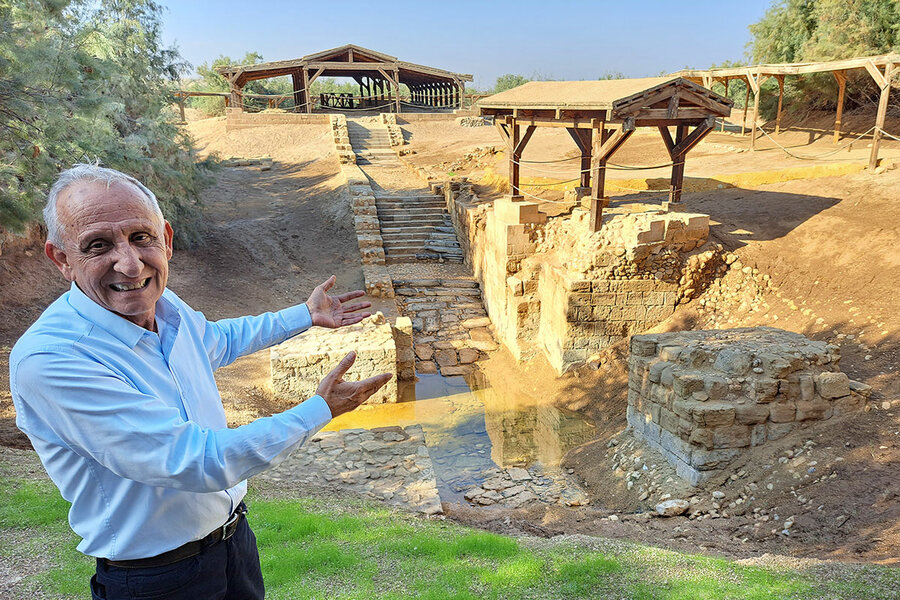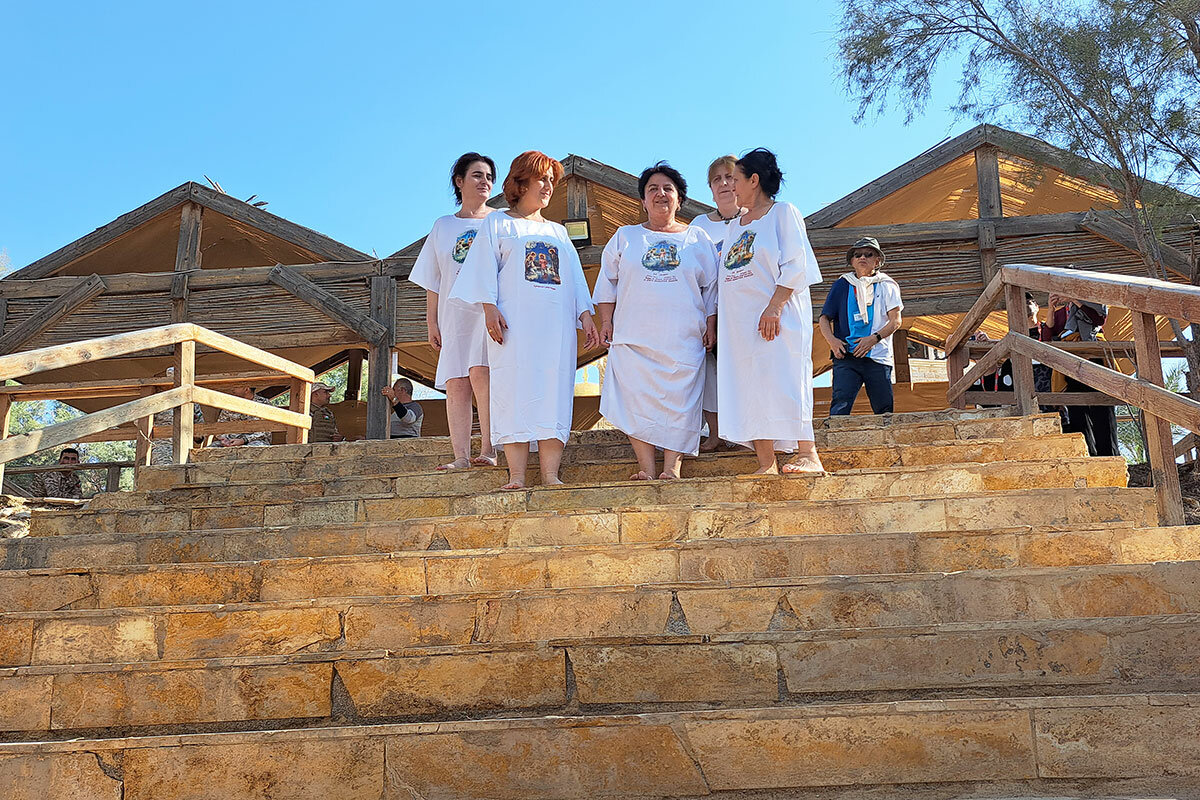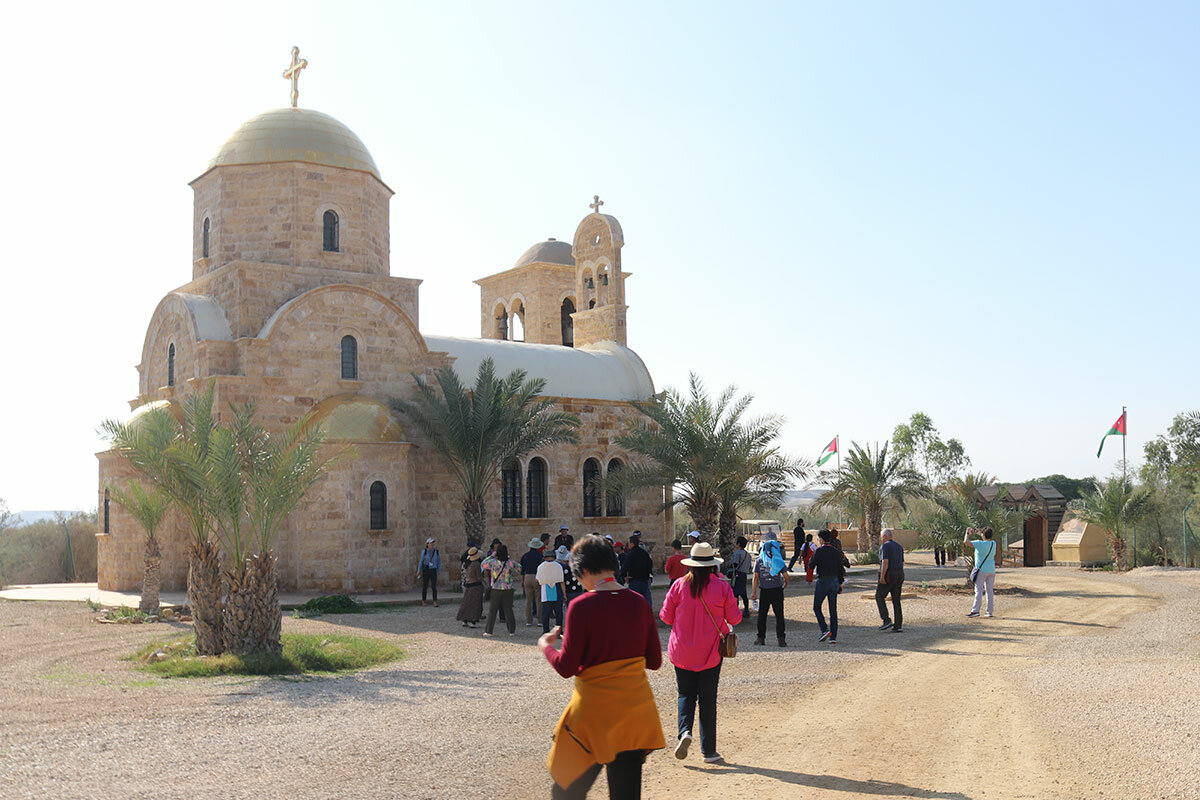On banks of the River Jordan, an interfaith haven is planned
Loading...
| BETHANY, Jordan
Wild reeds, spindly acacia trees, and dusty mountains greet travelers to this remote, arid spot. Yet here, near the lowest point on Earth, Jordan’s royal family is hoping visitors find something uplifting: their common humanity.
By the River Jordan, near the spot where many believe Jesus was baptized and John the Baptist held his ministry, Jordan is embarking on building a new village and vast interfaith ecosystem that is promised to be the largest Christian pilgrimage and interfaith center in the Middle East.
In a ceremony last week, King Abdullah unveiled a “baptism zone” masterplan, including a village, biblical wilderness, museum, farms, and spiritual and study center next to the traditional baptism site.
Why We Wrote This
A story focused onJordan’s Hashemite royal family, custodians of the site where many believe Jesus was baptized, hope a planned complex will be more than just a center for Christian pilgrims, but a showcase for Jordanian interfaith harmony.
The initiative brought together international advisers and a foundation directed by the monarch that they say is charged with creating a “haven for interfaith contemplation.”
Jordan and the Hashemite royal family, which acts as the custodian of the baptism site, hope the zone will be more than just a center for Christian pilgrims, but a gathering point for people of different faiths and nationalities and a showcase for Jordanian interfaith harmony.
Church leaders hope it will serve as an anchor for Christians from across the region.
“This will be a living city at the River Jordan and the site of baptism, a place and practice which unites Christians from all different churches and diversity,” says Cardinal Bechara Boutros al-Rai of Lebanon, Patriarch of Antioch for the Maronite Church, one of dozens of regional church leaders who attended the launch of the zone.
“Humanity needs a meeting place and a dialogue today, and the River Jordan is a meeting place not only for Christians, but for mankind.”
UNESCO site
The 360-acre baptism zone will be adjacent to Bethany Beyond the Jordan, a UNESCO World Heritage Site of preserved wilderness and Byzantine- and Roman-era churches and monasteries that was rediscovered in 1995 and has been visited by Catholic and Orthodox popes.
The new village would allow visitors to spend multiple days by the baptism site, which they are currently required to vacate by sunset due its location within an international border.
“This is a gem not only for Jordan but the entire world, and we want to share it with the world,” says Baptism Site Director General Rustom Mkhjian.
Advocates are pitching the zone, to include a guesthouse, outdoor amphitheater, and village square built with traditional Eastern Mediterranean architecture and materials, as a place to explore the humble simplicity of the area, suitable for spiritual retreats. It sets aside a 100-acre “wilderness” containing flora and fauna mentioned in the Bible, with hiking trails down to the River Jordan.
“The baptism site is a sanctuary and haven of love, peace, and tranquillity. This zone is designed to be in harmony with nature, just as people were in harmony with nature 2,000 years ago, to share this light with the world,” says landscape architect Kamel Mahadin, lead designer in the consortium of Jordanian and American firms tasked with designing the zone.
Jordan hopes the zone can boost the number of visitors to the site – currently 200,000 to 240,000 annually – to more than a million per year.
Development of the site is expected to take several years. The Jordanian state is donating the land and inviting private investors to operate the guesthouse and restaurants. Much of the zone – such as the botanical gardens and museum campus – will require donations.
Message of peace
Bethany’s modern history is tied to the power of peace.
It was only the 1994 peace treaty between Jordan and Israel, ending decades of enmity, that allowed for the demining of the Jordan Valley and eventual exploration and rediscovery of the religious site.
When late Franciscan archaeologist Michele Piccirillo and Prince Ghazi bin Mohammed, the king’s cousin and current chair of the Baptism Site Commission, surveyed archaeological remains along historical pilgrimage paths by the River Jordan in 1995, the pair walked between unexploded ordnance for hours.
“This place has gone from an area full of land mines to an area full of pilgrims from across the world in just 27 years,” Mr. Mkhjian says while greeting visitors in Russian and Italian as they walk down to the river on a December afternoon.
“What greater message of peace is there? That is the message we want to share with the world.”
Advocates say the new zone’s museum campus and research center are to encourage scholars and visitors to explore the message of peace in the three Abrahamic religions at a site with significance to Christianity, Islam, and Judaism.
“Christianity took its first steps from here, the lowest point on Earth and in the wilderness, before spreading across the world,” says Jordanian Nadim Muasher, an adviser on the zone who is currently building a Catholic church and nondenominational prayer center by the baptism site.
“This is about spreading the concept of humility and emphasizing values, not power. It is a message needed in today’s world,” Mr. Muasher says.
Culture of acceptance
It is also a message that is distinctly Jordanian.
A largely arid junction of trade routes linking North Africa, Asia and Europe, Jordan has acted as a place of refuge since antiquity, welcoming John the Baptist and early Christians fleeing persecution, and wave after wave of refugees and migrants through the centuries. The result is a culture of acceptance Jordanians say they aim to share with the world.
“With the arrival of Islam, Christians here embodied their Christian values by treating their Muslim neighbors and friends with love, friendship and respect, and Muslims embodied their Islamic values by treating their Christian friends and neighbors with love, friendship and respect,” says Fr. Dr. Ibrahim Dabbour, secretary-general of Jordan’s Council of Churches.
“There is equality and a harmony built on accepting and loving the other in Jordan that is special, which visitors to the zone can see.”
The baptism site already hosts an interfaith conference center and a Muslim shrine and mosque; thousands of Muslims and other non-Christians visit it each year.
On a recent afternoon, Irish, Italian, Georgian, Japanese, Jordanian, Lebanese, and Russian pilgrims and visitors walked through the site and down to the river; some waded into the water, others took photos or gazed across toward Jericho and Jerusalem beyond.
Yet they, like all pilgrims, arrived in individual buses and cars, rarely mingled or mixed, and quickly departed – heading off for luxury hotels at the Dead Sea or in the capital Amman.
Planners hope the new village will encourage people of different faiths and nationalities to stay in the same guesthouse and break bread at communal tables in the village plaza.
Stuart Jones, a former U.S. ambassador to Jordan and later Iraq who served as an adviser on the zone, says King Abdullah’s vision is for a “haven for interfaith dialogue and interfaith contemplation.”
“There is always going to be a need for a place like this where people can come for pilgrimage, for reflection, and to have a dialogue between peoples,” he says.








